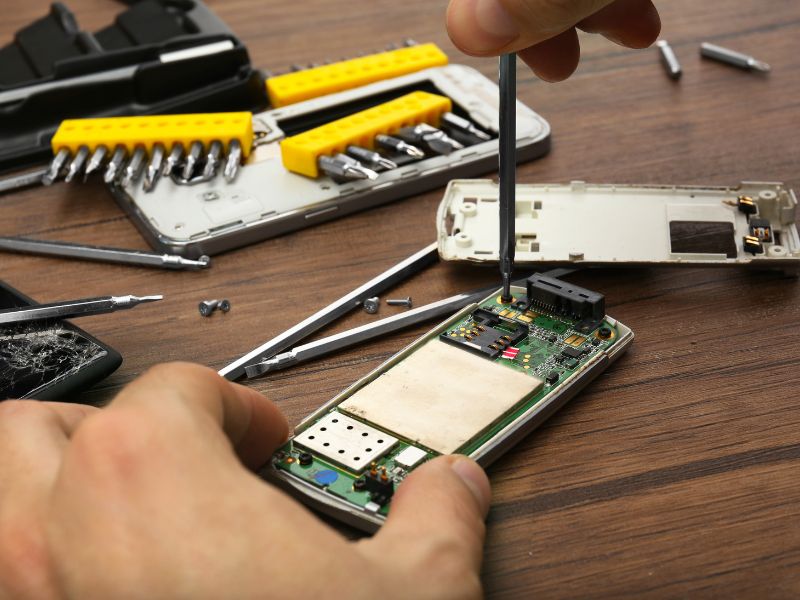GECO - Sustainability virtual italian fair
-
Virtual fair
- About us
- Expo event
- Press & Media
- Thematic areas
- How to participate
- Exhibitors
-
Sponsors
- Sponsorship
- Visibility
- Community
- Blog
- Login
-

Every day we use a lot of products and devices that break down after a few years and we can not repair them because we do not have the necessary information from the manufacturer. This is the case with laptops, smartphones, tvs and even cars. The challenge with this issue is that nowadays we have limited options when it comes to our old electronics: in most cases we are compelled to discard equipment that has stopped working and buy new gadgets - which is causing an environmental disaster. But is this really the only solution? Is there a way to have better products that you can also repair when they break down? This depends on the design of the product but also on how we change from a "buy and discard" society to a more sustainable society which is just not based solely on consumption. This is why the right to repair is so important.
The problems with recycling remain the same: it is expensive, slow and it recycles only a part of your products. The consumer market demands high quality at low prices, which makes manufacturers produce goods so that they are easy to discard and replace, rather than repair efficiently. The right to repair, which is increasingly being acknowledged worldwide, demands that the manufacturer of a product provide owners and independent repair businesses with fair access to service information, security updates, and replacement parts.
Sustainability today is beyond reuse and recycling of products and parts. It includes reducing waste in the first place, being more efficient with resources and energy, and creating less toxic materials. The concept of sustainability is now well accepted by companies across all industries, as they seek to minimize their environmental impact while improving their bottom line. Not only has it become a key business imperative, but also an ethical necessity for business leaders who want to leave the world a better place for future generations. The fact that consumers have been clamoring for legislation on their right to repair, in this context, is simply a logical consequence.

The standard model for electronics manufacturers is to design their products to be disposable. They don’t want customers to fix them, because it cuts into their profits. But we know that extending the life of electronic devices through customer-enabled repair is an effective option for sustainability. It’s also good for your wallet — which is why so many people are doing it themselves. Repairing electronics has many benefits for both consumers and businesses. It reduces waste and e-waste, extends the life of electronics and keeps them out of landfills, and helps consumers save money on costly new devices.
The repair economy is also good for business because it can provide a competitive advantage over competitors by offering better customer service.
The right to repair is a growing movement around the world. It's also a basic consumer right that should be part of every electronics company's business plan. The right to repair is about giving people access to affordable products that can be repaired by anyone, anywhere and at any time. The goal is to reduce waste and pollution, save consumers money and promote innovation.
Manufacturers should build products in ways that allow customers to repair them on their own or send them back to the manufacturer for repairs. The alternative is for consumers to pay for expensive repairs or throw away broken devices — both of which are bad for businesses, consumers and our planet alike. The pressure has led to some legislation being passed in various countries and to some producers, like Samsung and Apple, are starting to implement corporate policies in this direction.
Repairable electronics and appliances have been a growing movement for years, but the passage of the Fair Repair Act in New York in June of 2022 has brought it to the forefront. This law makes it easier for people to repair their own devices and provides protections against manufacturers who try to prevent them from doing so. Manufacturers are required to design products to be repairable, partner with local suppliers or develop them, unbundle hardware and software, adopt standards and empower their customers for ease of repair.
These days, the typical approach to old electronics is to use it until it stops working and then dispose of it for recycling. But there are more sustainable alternatives! For example, some products are now designed to be much easier to repair and upgrade. By changing our attitudes and investing in high quality, repairable products, we can make a massive contribution to solving the global waste problem.
If you are interested in sustainability issues, Join our platform!
Published on 13-07-2022